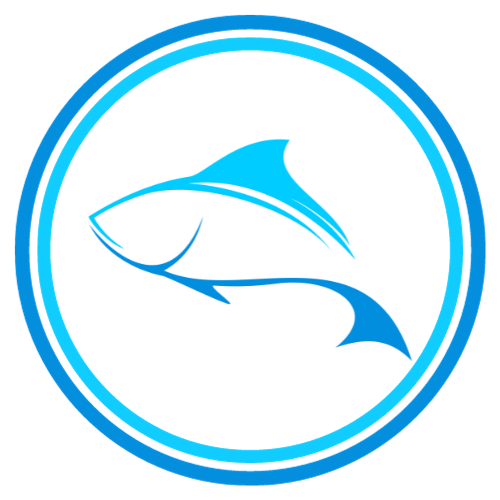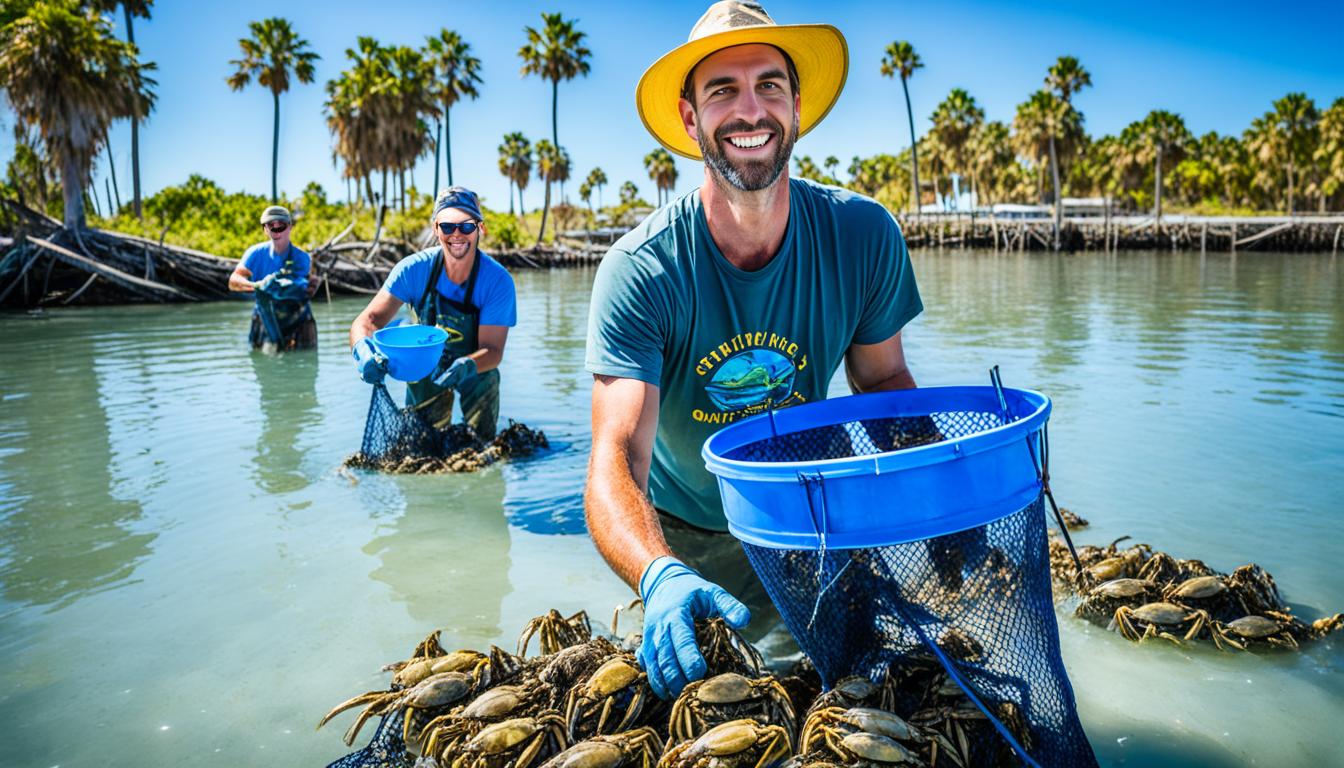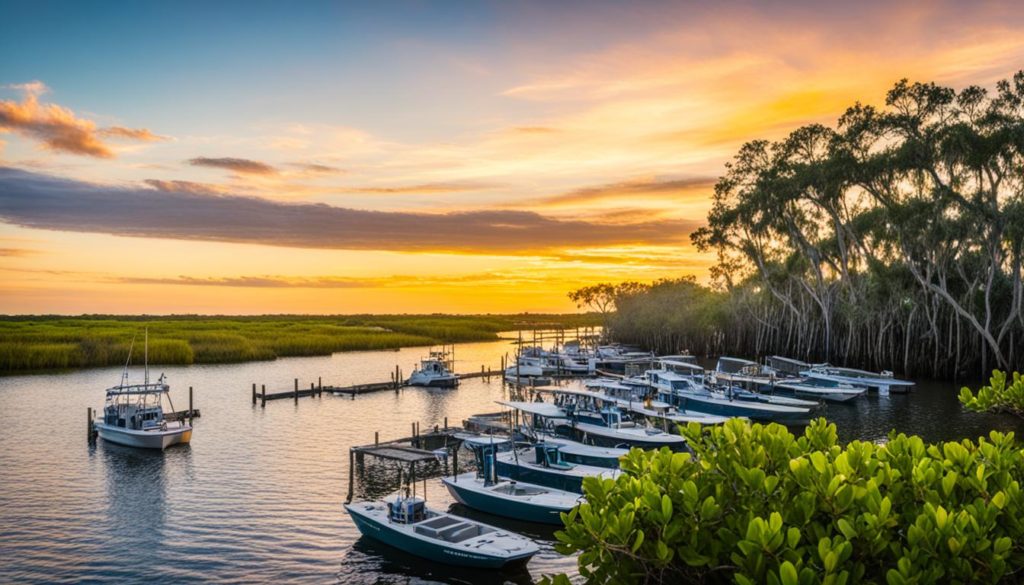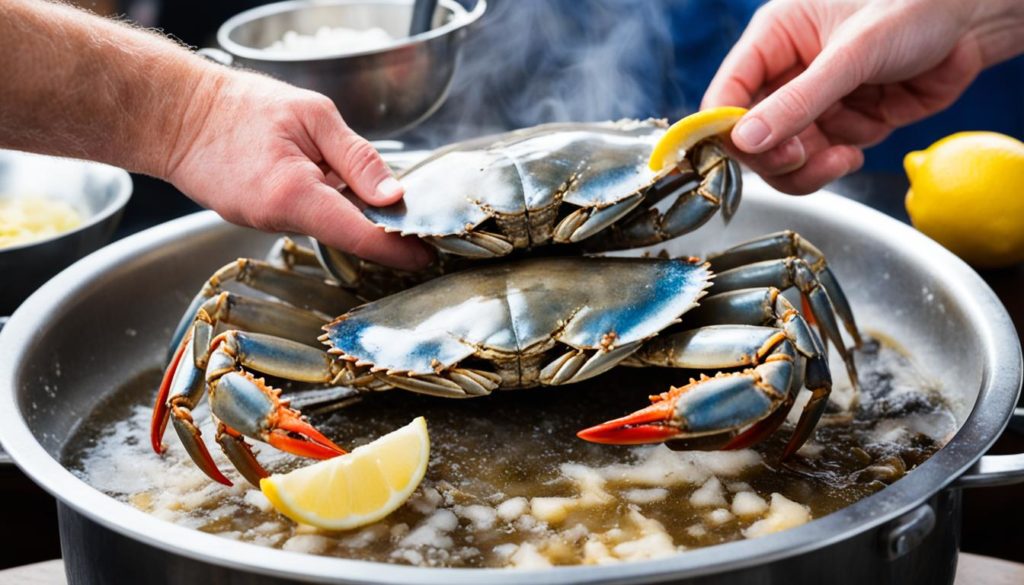If you’re looking for a fun and rewarding outdoor activity in Florida, crabbing for blue crabs is the perfect choice. Florida’s vast coastline provides abundant opportunities to catch these delicious crustaceans. Whether you’re a seasoned crabber or a beginner, this guide will provide you with valuable tips and techniques on how to catch blue crabs in Florida.
Key Takeaways:
- Blue crabs can be found on both the Atlantic and Gulf coasts of Florida.
- Productive crabbing spots in Florida include areas near the Skyway Bridge and Card Sound Road.
- Pyramid-shaped traps baited with chicken parts or oily fish are popular for shore fishing.
- Check Florida blue crab regulations for trap limits and licensing requirements.
Types of Crab Traps and Regulations in Florida
Before heading out to catch blue crabs in Florida, it’s essential to familiarize yourself with the state’s regulations. The Florida blue crab regulations ensure the sustainability and conservation of this precious seafood resource. These regulations may include restrictions on the number of traps that can be used and licensing requirements.
There are different types of crab traps available, designed to cater to various crabbing scenarios. Let’s take a closer look at two popular trap options:
1. Pyramid-Shaped Traps: These traps are commonly used for shore fishing and are shaped like pyramids. They are built with wire mesh, allowing the crabs to enter easily while preventing them from escaping. Pyramid-shaped traps are versatile and suitable for both recreational and commercial crabbing.
2. Wire Mesh Rectangle Traps: Ideal for use from a boat, these traps are designed in the shape of a rectangle. They are equipped with wire mesh walls and a door that allows the crabs to access the bait. Wire mesh rectangle traps are sturdy and effective in catching blue crabs.
It’s important to note that the non-commercial limit for crabbing in Florida typically allows the use of up to five traps per person. However, it’s crucial to consult the most current regulations to ensure compliance.
When crabbing, it’s essential to prioritize the conservation of the blue crab population. Release any crabs carrying eggs on their bellies, as they contribute to the future generation. Additionally, release small crabs to allow them to grow and contribute to the ecosystem.
“Understanding and adhering to Florida’s blue crab regulations is crucial for sustainable crabbing and the preservation of this valuable resource.” – Florida Department of Fish and Wildlife Conservation
| Type of Trap | Use |
|---|---|
| Pyramid-Shaped Traps | Shore fishing |
| Wire Mesh Rectangle Traps | Use from a boat |
Bait for Blue Crabbing in Florida
When it comes to blue crabbing in Florida, choosing the right bait can make all the difference in attracting these scavenging creatures. While blue crabs are known to eat almost anything, using bait that they typically consume will significantly increase your chances of success.
There are several types of bait that are commonly used in blue crabbing in Florida:
- Chicken Parts: Chicken parts, such as wings or drumsticks, are a popular choice among crabbers. The scent and flavor of chicken attract blue crabs, enticing them to enter your traps.
- Fish Heads: Another effective bait option is fish heads. They release a strong fishy odor that appeals to blue crabs, making them irresistible targets.
- Oily Fish: Blue crabs are particularly fond of oily fish, such as mullet or menhaden. The natural oils from these fish create a tantalizing scent that draws blue crabs towards your traps.
Remember, securing the bait properly in your trap is crucial to prevent crabs from stealing it. Make sure to attach the bait securely, ensuring that it remains intact throughout the crabbing process.
Here’s a helpful tip: consider using bait bags or bait cages to hold the bait within the trap. This will deter crabs from quickly devouring the bait and escaping without getting trapped.
By using the right bait and taking the necessary precautions, you’ll maximize your chances of a successful blue crabbing experience in Florida.
Where to Catch Blue Crabs in Florida
Florida offers a variety of locations where you can find blue crabs, providing ample opportunities for crabbing enthusiasts. Whether you prefer bays, beaches, bayous, or bridges, there are plenty of crabbing spots in Florida to explore. However, it’s important to know where to look to increase your chances of a successful catch.
Sandy beaches may not be the most ideal crabbing spots as there are fewer hiding places for the crabs to seek refuge from predators. Instead, focus your efforts on areas where grass beds are present. These grass beds not only offer cover for the crabs but also serve as a source of food, attracting them to these locations.
Additionally, bridge pilings can be highly productive spots to find blue crabs. The structures provide a sheltered habitat where crabs can seek protection and forage for food. When choosing a bridge, consider areas where there is a strong current or tidal flow, as these conditions can increase the likelihood of finding blue crabs.
Discover the crabbing spots in Florida that offer the best chances of catching blue crabs. Choose between bays, beaches, bayous, or bridges, and focus on locations with grass beds or bridge pilings for optimum success.
Crabbing Spots in Florida
| Location | Type of Spot |
|---|---|
| St. Petersburg/Tampa (near Skyway Bridge) | Bridge Piling |
| Key Largo (Card Sound Road area) | Grass Bed |
| Everglades National Park | Bayou |
| Pensacola | Beach |
Equipment for Catching Blue Crabs in Florida
To catch blue crabs in Florida, you will need the right equipment. Having the appropriate gear not only increases your chances of success but also ensures a more enjoyable crabbing experience. Here are some essential tools and equipment for catching blue crabs in Florida:
1. Crab Traps
Crab traps are the primary equipment used to catch blue crabs. You can purchase them at local tackle shops or outdoors superstores. There are different types of traps available:
- Pyramid-Shaped Traps: These traps are popular for shore fishing. They are designed to attract crabs and easily capture them.
- Wire Mesh Traps: These traps come in a rectangular shape and can be used from a boat.
Choose the trap style that best suits your fishing location and preferences.
2. Bait Container
A bait container is essential for securely holding the bait inside the trap. This prevents crabs from stealing the bait without getting caught. Make sure to choose a container that fits securely inside the trap.
3. Bait
Using the right bait increases your chances of attracting blue crabs. Some commonly used baits for blue crabbing in Florida include:
- Chicken Parts
- Fish Heads
- Other Oily Fish
Securely attach the bait to the trap to make it enticing for the crabs.
4. Handling Gloves
When handling blue crabs, it’s essential to protect your hands from their sharp claws. Invest in a pair of sturdy gloves that provide grip and protection against accidental pinches.
Using the right equipment significantly enhances your crabbing experience in Florida. With the proper traps, bait, and protective gear, you’ll be well-prepared to catch blue crabs and have a memorable adventure on the Florida coast.
Tips for Catching Blue Crabs in Florida
When crabbing in Florida, it is helpful to follow some tips and techniques for better success. Here are some effective methods and best techniques for blue crabbing in Florida:
- Choose the right time: Timing is crucial when it comes to crabbing. It is recommended to go crabbing during the outgoing tide when crabs are more active and easily accessible.
- Focus on areas with floating grass: Look for areas with floating grass, as they provide cover and serve as a source of food for blue crabs. These areas are often rich in crab populations.
- Use a long-handled crab net: Utilize a long-handled crab net to make it easier to scoop up crabs while walking along the beach. This allows you to reach crabs in shallow waters without getting too close.
- Handle crabs with care: It is important to handle crabs carefully to avoid getting pinched. Grab them from the back to prevent getting nipped by their claws.
- Follow Florida blue crab regulations: Always be aware of and adhere to Florida blue crab regulations. These regulations ensure the sustainability of crab populations and help protect the ecosystem.
The key to successful blue crabbing in Florida lies in choosing the right time, focusing on areas with floating grass, using the right equipment, and respecting regulations.
To get a better understanding of these tips, refer to the table below for a visual guide:
| Tips for Catching Blue Crabs in Florida | Description |
|---|---|
| Choose the right time | Go crabbing during the outgoing tide for optimal crab activity. |
| Focus on areas with floating grass | Search for areas with floating grass, as they attract and host blue crabs. |
| Use a long-handled crab net | Make use of a long-handled crab net to safely catch crabs along the beach. |
| Handle crabs with care | Practice caution and grip crabs from the back to avoid getting pinched. |
| Follow Florida blue crab regulations | Adhere to the regulations set forth by the state to protect the crab population. |
How to Cook Blue Crabs
Once you have caught blue crabs in Florida, the next step is to cook them. One popular method is to boil them in a pot of spicy crab boil seasoning. You can also steam them. It is important to ensure that the crabs are alive when you begin cooking and to season the water with spices of your choice. Once the shells turn a vibrant red color, you can crack them open and enjoy the sweet white meat of the claws and body.
Boiling Method:
1. Fill a large pot with water and add your chosen spices, such as crab boil seasoning, bay leaves, and garlic.
2. Bring the water to a rolling boil.
3. Carefully add the live blue crabs to the boiling water and cover the pot.
4. Boil the crabs for about 10-12 minutes or until their shells turn a vibrant red color.
5. Remove the crabs from the pot using tongs or a slotted spoon and transfer them to a platter.
6. Let the crabs cool slightly before cracking them open and enjoying the succulent meat.
Steaming Method:
1. Place a steaming rack or a steamer basket in a large pot filled with 1-2 inches of water.
2. Add your preferred seasonings, such as Old Bay seasoning or a combination of herbs and spices, to the water.
3. Bring the water to a boil.
4. Carefully add the live blue crabs onto the steaming rack or in the steamer basket, making sure they are not submerged in the water.
5. Cover the pot and steam the crabs for about 20-30 minutes or until their shells turn a vibrant red color.
6. Remove the crabs from the pot and let them cool slightly before cracking them open and savoring the delectable meat.
Whether you choose to boil or steam your blue crabs, they are sure to delight your taste buds with their tender, sweet flesh. Remember to pair them with your favorite dipping sauces and enjoy!
Other Uses for Blue Crabs
Blue crabs are not only delicious, but they also have a variety of other uses beyond cooking. The versatile meat of blue crabs can be incorporated into numerous dishes, adding a unique flavor and texture.
- Blue crab meat can be used to make crab cakes, a popular dish loved for its savory taste and crispy exterior.
- The sweet and delicate meat of blue crabs can also be added to pasta dishes, salads, or soups to enhance flavor and create a satisfying meal.
- For those who enjoy seafood dips, blue crab meat can be used as an appetizing ingredient, providing a rich and creamy texture to the dip.
If you’re looking for a simple and indulgent way to enjoy blue crabs, try dipping the meat in melted butter. The combination of the sweet crab flavor and the richness of butter creates a mouthwatering experience.
Blue crabs are a versatile seafood option that can be enjoyed in different ways, whether you’re adding them to your favorite recipe or savoring their natural flavors.
Florida Blue Crab Regulations
When it comes to crabbing in Florida, it’s essential to understand and abide by the state’s blue crab regulations. These regulations are in place to ensure the sustainability of the blue crab population and to protect the delicate ecosystem. By following these regulations, you can enjoy crabbing while also preserving the natural resources.
Limits on traps: Florida blue crab regulations may impose restrictions on the number of traps that can be used. This limit is in place to prevent overfishing and excessive harvesting. It is important to check the specific regulations for the area you plan to crab in to determine the maximum number of traps allowed.
Licensing requirements: In order to engage in blue crabbing in Florida, a valid recreational fishing license may be required. This license helps support conservation efforts and ensures responsible fishing practices. Make sure to obtain the necessary license before heading out to crab.
Size and gender restrictions: Florida blue crab regulations often include minimum size limits for the crabs that can be kept. This regulation is aimed at allowing the crabs to reach maturity and reproduce before being harvested. Additionally, certain regulations may apply to female crabs carrying eggs, as they play a vital role in the future generations of blue crabs.
To stay compliant with the regulations, it is important to stay informed of any updates or changes. These regulations may vary depending on the specific location, time of year, and other factors. To find the most current regulations, visit the Florida Fish and Wildlife Conservation Commission’s website or contact the local wildlife authorities.
By respecting and adhering to the Florida blue crab regulations, you can contribute to the long-term sustainability of the blue crab population and ensure future generations can also enjoy the thrill of crabbing in the beautiful waters of Florida.
Benefits of Crabbing in Florida
Crabbing in Florida offers numerous benefits. It can be a cost-effective way to enjoy outdoor recreation and connect with nature.
When you go crabbing, you get to spend time in the beautiful coastal areas of Florida, surrounded by breathtaking scenery and abundant wildlife. The experience of being out on the water, feeling the breeze on your face, and listening to the sounds of nature can be incredibly relaxing and rejuvenating.
Not only is crabbing a great way to unwind and destress, but it also provides an opportunity to bond with family and friends. It’s a fun activity that everyone can participate in, regardless of age or skill level. Whether you’re teaching your kids how to set traps or competing with your friends to see who can catch the most crabs, crabbing in Florida creates lasting memories and strengthens relationships.
One of the biggest benefits of crabbing in Florida is the opportunity to enjoy fresh and delicious seafood. When you catch your own blue crabs, you have the satisfaction of knowing exactly where your food came from and how it was caught. You can prepare the crabs in a variety of ways, from boiling them in a pot of spicy crab boil seasoning to steaming them to perfection. The sweet and succulent meat of the blue crabs is a true delicacy that you can savor and share with your loved ones.
Crabbing in Florida also allows you to connect with the local culinary traditions. The state is renowned for its seafood cuisine, and by catching your own blue crabs, you can experience the authentic flavors and preparations that make Florida’s seafood so special. Whether you’re enjoying a crab feast with friends or experimenting with new recipes in your own kitchen, crabbing in Florida opens up a world of culinary possibilities.
Crabbing in Florida offers an affordable way to enjoy the outdoors, bond with loved ones, savor fresh seafood, and connect with the local culinary heritage.
So, seize the opportunity to go crabbing in Florida and enjoy the many benefits it brings. Whether you’re a seasoned crabber or a beginner, the thrill of the catch, the joy of being in nature, and the satisfaction of a delicious meal await you.
Tips for Crabbing Success in Florida
When it comes to crabbing in Florida, following some essential tips can significantly increase your chances of a successful catch. By choosing the right locations, using the appropriate equipment, and using bait that is irresistible to blue crabs, you’ll maximize your crabbing experience. Additionally, timing your expeditions to coincide with the outgoing tide can further enhance your chances of success.
1. Choose the Right Locations
Florida offers a wide range of spots for crabbing, but some are more productive than others. Look for areas near grass beds and bridge pilings, as these are popular habitats for blue crabs. Consider locations like the areas near the Skyway Bridge towards Tampa and the Card Sound Road heading towards Key Largo. These spots have proven to be productive for many recreational crabbers.
2. Use the Appropriate Equipment
To maximize your crabbing success, it’s crucial to have the right equipment. Start with crab traps, such as pyramid-shaped traps for shore fishing or wire mesh traps in the shape of a rectangle for boat fishing. Choosing the right trap type based on your fishing location and needs is vital. You can purchase these traps at local tackle shops or outdoors superstores.
3. Use Bait That Appeals to Blue Crabs
Blue crabs are scavengers and will eat almost anything, but using bait that they find particularly tempting is key to attracting them to your trap. Consider using chicken parts, fish heads, or other oily fish as bait. Securely attach the bait to the trap to prevent crabs from easily stealing it and increase your chances of a successful catch.
4. Time Your Crabbing Trips
The timing of your crabbing trips can significantly impact your success. Plan your excursions around the outgoing tide, as this is when crabs are more active and likely to be feeding in the shallow waters. By aligning your trips with the tide, you’ll increase your chances of encountering and catching blue crabs.
5. Handle Crabs Carefully and Follow Regulations
It is essential to handle crabs with care to avoid injuring yourself or the crabs. Crabs have sharp claws and can pinch, so approach them cautiously. Additionally, be sure to follow all Florida blue crab regulations. These regulations may include limits on trap numbers, licensing requirements, and restrictions on crab size and gender. Staying compliant with these regulations helps preserve the crab population and ensures a sustainable fishing experience for future crabbing enthusiasts.
By following these tips, you’ll increase your chances of a successful crabbing adventure in Florida. Catching blue crabs can be an exciting and rewarding experience, providing you with fresh seafood and a deeper connection with nature. Remember to always prioritize safety and conservation while enjoying this popular recreational activity.
Conclusion
Crabbing for blue crabs in Florida is a popular and exciting activity that can provide you with a delicious bounty of fresh seafood. By utilizing the tips and techniques mentioned throughout this article, you can enhance your success in catching blue crabs and maximize your crabbing experience. Remember to abide by the Florida blue crab regulations, as these guidelines ensure the sustainability and preservation of this valuable resource.
Exploring the various crabbing spots in Florida, such as the grass beds and bridge pilings, will increase your chances of encountering these delectable creatures. Equipping yourself with the right tools, such as pyramid-shaped traps for shore fishing or wire mesh traps for boat crabbing, will further optimize your crabbing efforts.
Choosing the appropriate bait, such as chicken parts or oily fish, will entice blue crabs to your traps and increase your catch. Timing your crabbing trips to coincide with the outgoing tide can also prove advantageous.
Embark on your crabbing adventure in Florida, armed with the insights and knowledge shared in this article, and immerse yourself in the thrill of catching and cooking your own fresh blue crabs. Enjoy the experience and savor the mouth-watering flavors of this delectable seafood delicacy.
FAQ
How do I catch blue crabs in Florida?
To catch blue crabs in Florida, you can use crab traps with bait such as chicken parts or fish heads. Look for productive crabbing spots like grass beds and bridge pilings.
What are the regulations for blue crabbing in Florida?
Florida blue crab regulations include limits on the number of traps allowed and licensing requirements. It is important to check the most up-to-date regulations before crabbing.
What kind of traps should I use for blue crabbing in Florida?
Pyramid-shaped traps are popular for shore fishing, while wire mesh traps in the shape of a rectangle can be used from a boat.
What type of bait should I use for blue crabbing in Florida?
Commonly used bait for blue crabbing in Florida includes chicken parts, fish heads, and other oily fish.
Where can I find blue crabs in Florida?
Blue crabs can be found in bays, bayous, bridges, and areas with grass beds. Sandy beaches are not the best place to find them.
What equipment do I need for catching blue crabs in Florida?
You will need crab traps, which can be purchased at local tackle shops or outdoors superstores. Choose the right type of trap for your fishing location and needs.
What are some tips for catching blue crabs in Florida?
Tips for catching blue crabs in Florida include choosing the right time to crab, focusing on areas with floating grass, and using a long-handled crab net.
How do I cook blue crabs?
Blue crabs can be boiled in a pot of spicy crab boil seasoning or steamed. Ensure that the crabs are alive when cooking and season the water with spices.
Can blue crabs be used for more than just cooking?
Yes, blue crab meat can be added to various dishes or used as an ingredient in recipes. Some people also enjoy eating blue crab meat dipped in butter.
What are the benefits of crabbing in Florida?
Crabbing in Florida offers a cost-effective way to enjoy outdoor recreation, connect with nature, and have fun with family and friends. It also allows you to enjoy fresh seafood and connect with the local culinary traditions.
What are some tips for crabbing success in Florida?
Tips for crabbing success in Florida include choosing the right locations, using the appropriate equipment, using bait that is appealing to blue crabs, and timing your trips to coincide with the outgoing tide.
What are the regulations for blue crabbing in Florida?
Florida blue crab regulations include limits on the number of traps that can be used, licensing requirements, and restrictions on the size and gender of crabs that can be kept. Check the most up-to-date regulations to ensure compliance.



